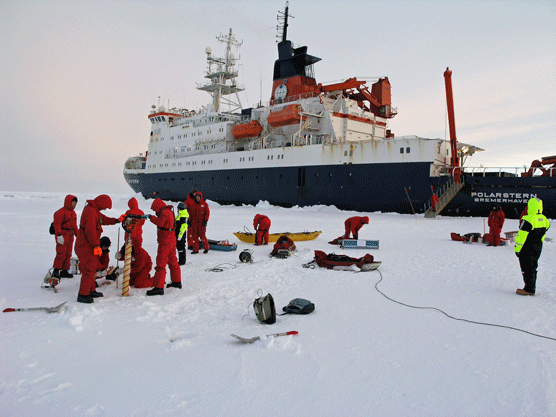Press release 2013-09-12 at 10:41

Ice research on the Antarctic waters. Photo: image copyright David N. Thomas
Underneath the pristine snow cover of the Arctic and Antarctic pack ice, there is a community of microscopic algae and bacteria that thrive within the ice itself. These ice-organisms are adapted to growing on the ice surfaces and within a labyrinth of channels and pores that permeate the ice floes.
It is a hostile place to grow with temperatures often below -10°C (reaching down to -20°C), low light and often very salty brines, six or seven times more salty that the seawater from where these organisms originate. Many marine organisms secrete gel-like substances in response to environmental stress, and it appears that these ice-dwellers are no exception. In fact they secrete large quantities of the gels that are made up from various types of polysaccharides. It has been discovered that these gels affect far more than the micro organisms they surround. Their presence may affect how carbon travels to the ocean floor and even the weather.
“The gels surround the cells, buffering them against extremes of temperature and salt. There is also evidence that the gels, or substances in the gels, may also alter the ice crystal formation, and so the structure of the ice itself” says David Thomas.
Since 2006 Professor Graham Underwood & Dr Shazia Aslam from the University of Essex and Professor David Thomas an Academy of Finland FiDiPro Research Professor at SYKE have led several projects (funded by the Natural Environment Research Council, U.K.) to study the production of micro-gels, and their widespread importance to the frozen realms of the worlds oceans. They teamed up with colleagues from Australia and Canada to collect and analyse ice cores from both the Arctic and Antarctic. Seven years on, and many frozen trips later they are publishing a rather surprising finding – They, and their co-workers found that there is a strong relationship - spanning ice from both the Arctic and Antarctic - between the physical nature of the ice, the amount of microbiology it contains and the concentrations of gels.
“It now means that we can estimate the concentration of gels in ice, by knowing rather routine measurements: the thickness of the ice floes, temperature and salinity of the ice and the amount of biology in the ice” says Thomas.
“This is a huge step forwards to enable us to estimate the significance of these materials to the millions of square kilometres of Antarctic and Arctic pack ice.”
Why this is important? The gels also promote the clumping together of cells when they are released from the ice when it melts. These sticky masses fall more rapidly to the sea floor, taking food (and carbon) out of the surfaces waters. There is also evidence that micro-gels at the ocean surface may get caught up into the air and eventually act as cloud condensing nuclei thereby affecting weather.
So gels produced to protect algae and bacteria in the ice, may have profound implications for the long-term burial of carbon to the ocean floor and even the weather. Over and above these issues the gels will be influencing the nature and structure of the ice itself.
More information
In English: Dr. David Thomas, Bangor University
tel. +45 29653117
d.thomas@bangor.ac.uk
In Finnish: Leading Researcher Harri Kuosa, SYKE
tel. +358 406737554
firstname.surname@ymparisto.fi
The work is published in the Proceedings of the National Academy of Science. Publication:
GJC Underwood, S Aslam, C Michel, A Niemi, L Norman, KM Meiners, J Laybourn-Parry, H Paterson & DN Thomas. 2013. Broad-scale predictability of carbohydrates and exopolymers in Antarctic and Arctic sea ice. Proceedings of the National Academy of Sciences of the United States of America, DOI 10.1073/pnas.1302870110
The article on the web: www.pnas.org
Photo to the media
Ice research on the Antarctic waters. Photo: David Thomas (4 Mb)